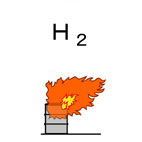| Case Name |
Fire in a fin-fan cooler at an outlet of the reactor at a fuel oil hydro-desulfurization unit |
| Pictograph |

|
| Date |
February 10, 2000 |
| Place |
Tomakomai, Hokkaido, Japan |
| Location |
Refinery |
| Overview |
The fire was caused by opening due to corrosion at a heat transfer tube of a fin-fan cooler at the reactor outlet of the hydro-desulfurization unit for fuel oil. The corrosion seems to have occurred due to following two reasons; a change of the crude oil type which was more corrosive than before and unequal flow distribution between heat transfer tubes of the cooler, which was not considered at a design stage. |
| Incident |
Leakage and a fire occurred at a heat exchanger, in which vapor from a high-temperature and high-pressure separator at the outlet of the reactor of a fuel oil hydro-desulfurization unit was partially condensed. One heat transfer tube of the fin-fan cooler was penetrated by corrosion, and there was a fire. The accident occurred at the reactor outlet side. A mixture consists of hydrogen, light hydrocarbon and washing water of 120 °C was cooled to 40 °C and partially condensed at the fin-fan cooler, via a vapor-liquid separator under high-temperature and high-pressure. |
| Processing |
Manufacture |
| Individual Process |
Reaction |
| Process Flow |
Fig2.Unit process flow
|
| Chemical Reaction |
Hydro-desulfurization |
| Substance |
Hydrogen, Fig3 |
| Ammonium chloride, Fig4 |
| Naphtha |
| Type of Accident |
Fire |
| Sequence |
The unit started operation in 1994. There were no special problems found with this heat exchanger at the third inspection in 1998, two years previously, except very slight corrosion. During usual operation, a fire occurred suddenly at 14:33 on February 10th, 2002 near the heat exchanger. |
| Cause |
The cause of corrosion of the heat transfer tube was assumed to be hydrogen chloride. In addition, the following fact was proven as a result of a flow analysis in the heat exchanger. "At both right and left sides of the upper stage of heat transfer tubes in each pass in the heat exchanger, the quantity of washing water decreased. Therefore, washing water, which had been condensed once, was reheated and part of the solved ammonium chloride was re-evaporated and hydrogen chloride was generated. In this heat transfer tube, the lower part in which liquid remains becomes an intensely corrosive environment." The oil type had been changed to Arabian heavy crude oil two years before, which has a high chlorine content compared to other kinds of crude oil. However, the concentration of chlorine was within the tolerance of the licenser. It seems that the ignition source was static electricity due to a spout of hydrogen. |
| Response |
Self-defense fire fighters and public fire fighters turned out. |
| Countermeasures |
It is important to maintain facilities. The piping material was SUS, but it is not certain if the material is suitable for crude oil with high content of chlorine as in this case. The level of impurities might be in the range of the licenser's manual, but when the oil type differs from the design, sufficient examination seems to be necessary. |
| Knowledge Comment |
Accidents at fuel oil desulphurization units occur very frequently. One of the causes is the presence of a corrosive material. This unit should be inspected with top priority in a refinery. |
| Background |
The accident might be inevitable. Other major accidents have also occurred at the same unit, attracting a lot of interest. In a normal design, the drift of every heat transfer tube in each pass of a heat exchanger is not considered. Despite the change of the oil type, impurity levels such as chlorine were in the range of the licenser's manual. However, attention should have been paid because the chlorine level increased. |
| Sequel |
Although this company is one of Japan's major petroleum companies, there was an accident at almost the same site two years later. The attitude of this company to safety was questioned. |
| Incidental Discussion |
Although there were no casualties, the fire continued for a long time.
Partial load distribution of the condenser became a problem. Although the design seemed to be sufficient to check surface temperature at a heat transfer tube, study of the unequal flow distribution between the tubes in the same pass was required in this case at a design stage to prevent the accident. This is a difficult design problem. |
| Reason for Adding to DB |
Example of fire caused due to unequal flow distribution between tubes in a fin-fan cooler |
| Scenario |
| Primary Scenario
|
Misjudgment, Misjudgment of Situation, Misjudgment by insufficient data, Insufficient Analysis or Research, Insufficient Prior Research, Mismatching of the Crude Oil and the Quality of Material, Poor Value Perception, Poor Safety Awareness, Inadequate Risk Recognition, Planning and Design, Poor Planning, Poor Operation Planning, Usage, Maintenance/Repair, No Measure against Slight Corrosion, Failure, Abrasion, Corrosion, Secondary Damage, External Damage, Fire
|
|
| Sources |
Fire and Disaster Management Agency, Fire of hydrogen leaking from the fin-fan cooler of fuel oil direct desulfurization unit. Accident cases of dangerous materials, pp.42-43. (2000)
I petroleum H refinery accident investigation committee, Investigation report on fire at fin-fan cooler of fuel oil direct desulfurization unit in I petroleum H refinery. (2000)
|
| Physical Damage |
A fin-fan cooler at the outlet side of the reactor in a fuel oil direct desulfurization unit was damaged by fire. |
| Financial Cost |
¥ 4 million. (Fire and Disaster Management Agency) |
| Multimedia Files |
Fig3.Chemical formula
|
|
Fig4.Chemical formula
|
| Field |
Chemicals and Plants
|
| Author |
KOSEKI, Hirosi (National Research Institute of Fire and Disaster)
TAMURA, Masamitsu (Center for Risk Management and Safety Sciences, Yokohama National University)
|